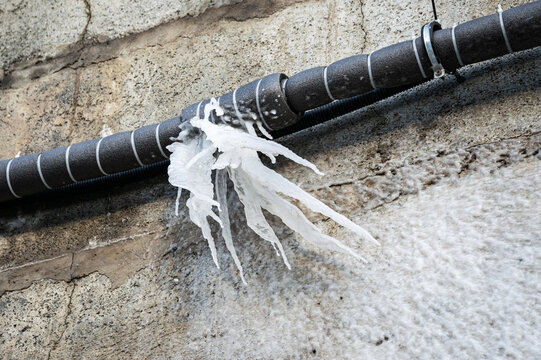Ways to Defend Your Pipes from Cold Weather: Specialist Guidance
Schedule HereHave you been trying to locate answers concerning Winter Plumbing Precautions: Preventing Frozen Pipes?

Winter can wreak havoc on your plumbing, particularly by freezing pipes. Here's how to avoid it from taking place and what to do if it does.
Intro
As temperature levels decrease, the danger of icy pipelines boosts, potentially leading to pricey fixings and water damages. Comprehending how to stop icy pipes is essential for homeowners in cool climates.
Avoidance Tips
Protecting vulnerable pipelines
Wrap pipelines in insulation sleeves or use warm tape to protect them from freezing temperature levels. Concentrate on pipes in unheated or outside locations of the home.
Heating methods
Keep indoor rooms effectively heated, especially locations with pipes. Open cupboard doors to allow warm air to circulate around pipes under sinks.
Exactly how to recognize frozen pipes
Try to find decreased water circulation from taps, unusual smells or noises from pipes, and noticeable frost on subjected pipelines.
Long-Term Solutions
Architectural adjustments
Take into consideration rerouting pipes away from exterior walls or unheated locations. Include added insulation to attic rooms, basements, and crawl spaces.
Upgrading insulation
Buy top quality insulation for pipes, attic rooms, and walls. Proper insulation aids keep constant temperatures and lowers the danger of frozen pipelines.
Safeguarding Outdoor Pipes
Garden tubes and outside taps
Detach and drain pipes garden tubes before winter months. Set up frost-proof faucets or cover outdoor taps with shielded caps.
Understanding Icy Pipelines
What causes pipes to ice up?
Pipelines ice up when exposed to temperatures below 32 ° F (0 ° C) for prolonged durations. As water inside the pipelines ices up, it increases, taxing the pipeline wall surfaces and potentially causing them to rupture.
Risks and damages
Frozen pipelines can lead to water disturbances, building damages, and expensive repair services. Ruptured pipes can flooding homes and trigger considerable structural damages.
Signs of Frozen Pipes
Recognizing icy pipelines early can prevent them from bursting.
What to Do If Your Pipelines Freeze
Immediate activities to take
If you suspect frozen pipelines, maintain taps available to soothe pressure as the ice melts. Utilize a hairdryer or towels taken in warm water to thaw pipes slowly.
Verdict
Stopping icy pipelines calls for positive steps and fast actions. By understanding the reasons, indicators, and preventive measures, home owners can safeguard their plumbing throughout winter.
6 Proven Ways to Prevent Frozen Pipes and Protect Your Home
Disconnect and Drain Garden Hoses
Before winter arrives, start by disconnecting your garden hoses and draining any remaining water. Close the shut-off valves that supply outdoor hose bibs and leave the outdoor faucet open to allow any residual water to drain. For extra protection, consider using faucet covers throughout the colder months. It’s also important to drain water from any sprinkler supply lines following the manufacturer’s directions.
Insulate Exposed Pipes
Insulating your pipes is an effective way to prevent freezing. Pipe insulation is readily available at home improvement stores and is relatively inexpensive. Pay close attention to pipes in unheated areas such as the attic, basement, crawl spaces, or garage. Apply foam insulation generously to create a buffer against the cold. You can also wrap your pipes in heat tape or thermostat-controlled heat cables for added warmth.
Seal Air Leaks
Inspect your home for any cracks or openings that could let in cold air. Seal any holes around the piping in interior or exterior walls, as well as the sill plates where your home rests on its foundation. Additionally, make sure to keep your garage door closed unless you’re entering or exiting. Leaving it open creates a significant air leak that can lead to frozen pipes.
Allow Warm Air Circulation
During cold snaps, it’s essential to allow warm air to circulate evenly throughout your home. Leave interior doors ajar to promote better airflow. Open kitchen and bathroom cabinets to help distribute heat consistently around the rooms. If you have small children or pets, be sure to remove any household chemicals or potentially harmful cleaners from open cabinets for safety.
Let Faucets Drip
A small trickle of water can make a big difference in preventing ice formation inside your pipes. When temperatures drop significantly, start a drip of water from all faucets served by exposed pipes. This continuous flow helps prevent the water from freezing. Additionally, running a few faucets slightly can relieve pressure inside the pipes, reducing the chances of a rupture if the water inside does freeze.
https://choateshvac.com/6-proven-ways-to-prevent-frozen-pipes-and-protect-your-home/

Hopefully you enjoyed our part on How to prepare your home plumbing for winter weather. Thank you for taking time to read through our blog post. Those who enjoyed our post plz be sure to pass it around. Thanks so much for your time spent reading it.
This Site